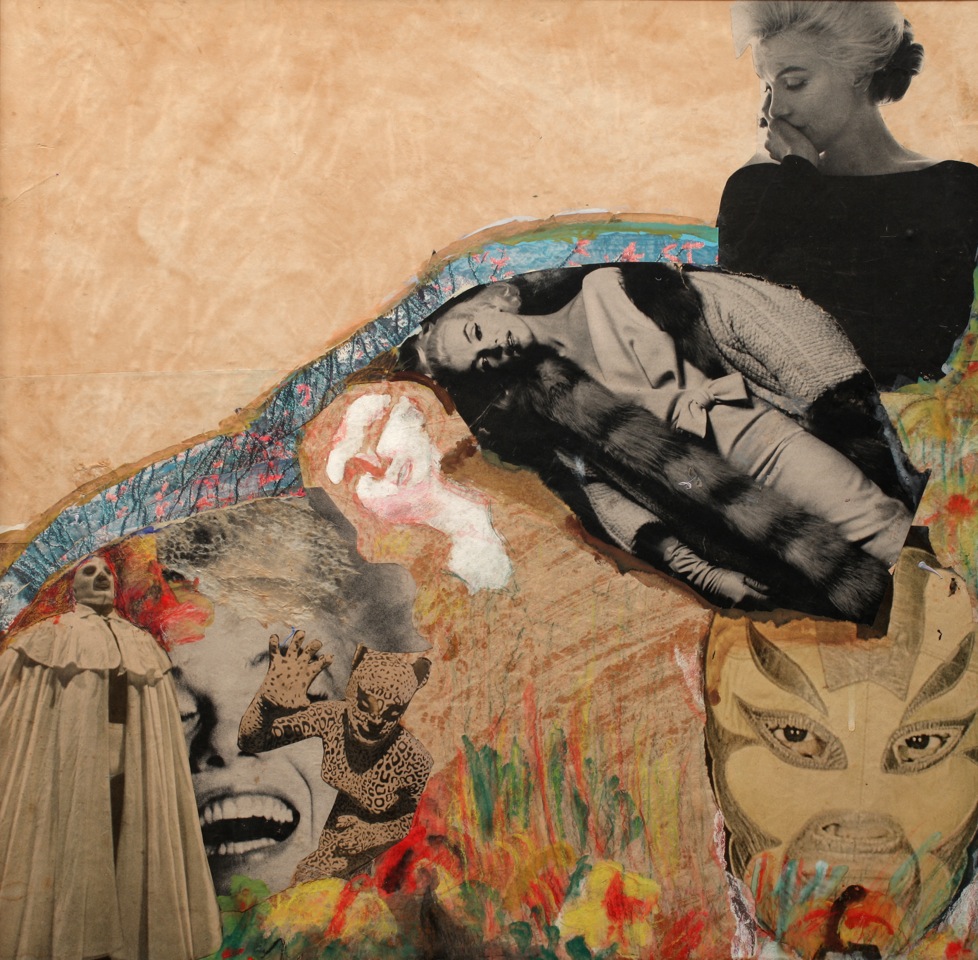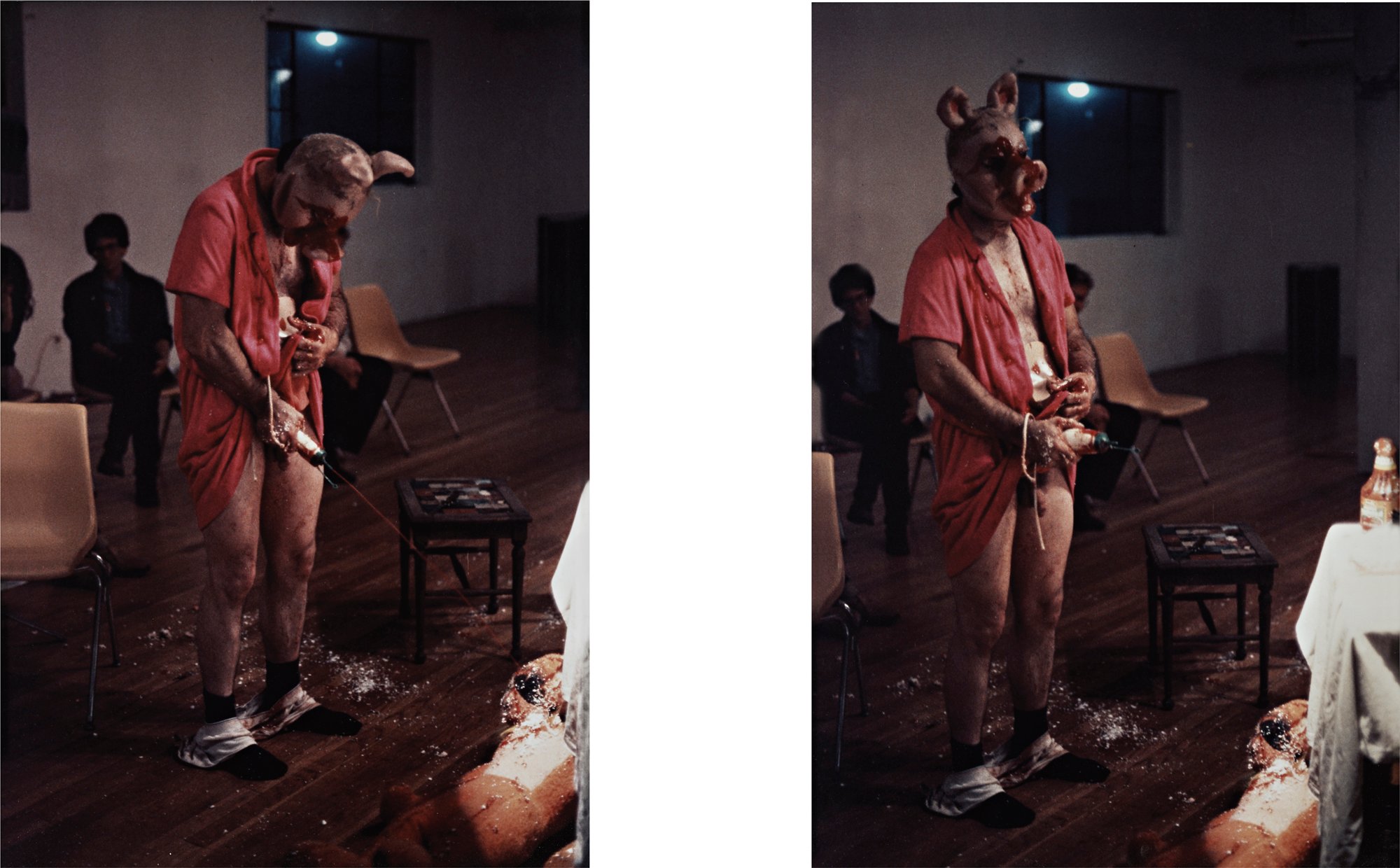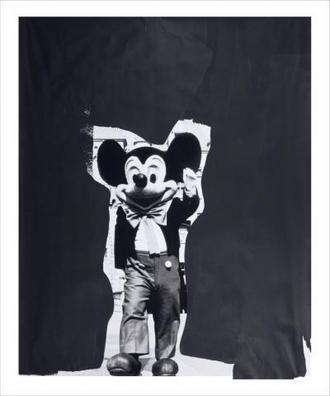
© » KADIST
Sharon Lockhart
Lockhart’s film Lunch Break investigates the present state of American labor through a close look at the everyday life of the workers at the Bath Iron Works shipyard—a private sector of the U. S. naval shipbuilding company—in Maine. Gary Gilpatrick, Insulator (2008) belongs to a group of portrait-like photographs of the shipyard’s workers lunchboxes. Created over the period of a year, Lockhart’s film and accompanying still photographs are intended as an exploration of the social spaces inside this kind of workplace.

© » KADIST
Sharon Lockhart
Lockhart’s film Lunch Break investigates the present state of American labor, through a close look at the everyday life of the workers at the Bath Iron Works shipyard—a private sector of the U. S. naval shipbuilding company—in Maine. Stanley “Tom” Durrell, Tinsmith (2008) belongs to a group of portrait-like photographs of the shipyard’s workers lunchboxes. Created over the period of a year, Lockhart’s film and accompanying still photographs are intended as an exploration of the social spaces inside this kind of workplace.

© » KADIST
Michelle Handelman
Michelle Handelman’s video work Irma Vep, The Last Breath takes its inspiration from Musidora, a famous French silent film actress, and a character she played called Irma Vep, from the film Les Vampires (1915), directed by Louis Feuillade. The work uses these characters as metaphors to highlight the lives of those who live in the shadows—or feel like they do—and the anxiety they experience as marginalized figures. Musidora was a 20th-century feminist, who was known not only for acting in movies, but also for directing her own plays and films, and having secret affairs with Colette and other famous people of the time.

© » KADIST
Michelle Handelman
In Dorian, a cinematic perfume, video is used as a community gatherer, a tool to speak about particular subcultures, in this case the trans-gender drag queen New York community, past and present. Developed from a literary work, it deconstructs notions of narrative forms, styles and conventions. It is a hybrid piece, an example of the elasticity of the medium.

© » KADIST
Nao Bustamante
Silver & Gold combines video, performance, and original costumes into a self-proclaimed “filmformance” that evokes the legendary filmmaker Jack Smith and his tribute to 1940s Dominican movie starlet Maria Montez in a magical and joyfully twisted exploration of race, glamour, sexuality, and the silver screen. Taking Smith’s interest in Hollywood’s obsession with the reproduction of the exotic as a point of departure, Bustamante embodies Miss Montez. Here, video and the body function as both material and subject in her bizarre search for the new bejeweled body part that is at once her curse and oracle.

© » KADIST
Fran Herndon
Working independently, Herndon experimented at the forefront of a now-canonical method—appropriation—by painting additions into found images from magazines such as Life and Sports Illustrated in a way that imbues the resulting works with mythical significance. Associated with the Beat movement, her work is integral to that part of the history of San Francisco. White Angel (1962), painted in the year of Marilyn Monroe’s death, portrays the actress in a process of devolution.

© » KADIST
Felipe Dulzaides
I Am Cuba— “Soy Cuba” in Spanish; “Ya Kuba” in Russian—is a Soviet/Cuban film produced in 1964 by director Mikhail Kalatozov at Mosfilm. The movie was not well received by the Russian or Cuban public and was almost completely forgotten until its rediscovery thirty years later by American filmmakers. The movie’s acrobatic tracking shots and idiosyncratic mise-en-scène prompted Hollywood directors like Martin Scorsese to campaign to restore the movie in the early 1990s.

© » KADIST
Nao Bustamante
Advanced Technology (Advanced Technology)
The Wooden People is a 360º virtual reality film series comprising seven episodes. It is written and directed by artist Nao Bustamante and its cast includes notable Los Angeles-based artists Gabriela Ruiz, rafa esparza, San Cha, Markus Kuiland-Nazario, Ron Athey, and Dorian Wood. The work also features a musical and sound score by Nick Hallett and costumes by OLIMA.

© » KADIST
Sharon Lockhart
Visalia Livestock Market, Visalia, California results from Lockhart’s prolonged investigation of an agricultural center and community. Lockhart traveled around California’s Central Valley, spending time with cattle ranchers on their properties and attending livestock auctions with them and getting a sense of the rhythm of their lives. Throughout this time, the artist shot more than one hundred four-by-five-inch negatives but chose to print just this one from the series.

© » KADIST
Barry McGee
Barry McGee’s Untitled is a collection of roughly fifty, framed photographs, paintings, and text pieces clustered together in corner. Its tiled effect can perhaps be seen as a vertical Carl Andre work and also bears some resemblance to another work in the Kadist Collection, Jedediah Caesar’s JCA-25-SC. McGee’s installation also echoes the votive altars in the chapels he visited during his residency in Brazil in 1993.

© » KADIST
Kota Ezawa
The Crime of Art is an animation by Kota Ezawa that appropriates scenes from various popular Hollywood films featuring the theft of artworks: a Monet painting in The Thomas Crown Affair (1999), a Rembrandt in Entrapment (1999), a Cellini in How to Steal a Million (1966), and an emerald encrusted dagger in Topkapi (1964). Ezawa uses his signature cartoon-like style to remix and reenact these crime scenes, leaving only the artworks as “real” objects (as they are depicted in the films), rather than illustrating them. Reversing fiction and reality in an unexpected way, this gesture invites the viewer to question the reliability of the visual footage.

© » KADIST
Ana Teresa Fernández
Drawing & Print (Drawing & Print)
The artist writes about her work Borrando la Frontera, a performance done at Tijuana/San Diego border: “I visually erased the train rails that serve as a divider between the US and Mexico. I painted them sky blue, creating a “Hole in the Wall” This deconstruction of “feminized” work explores the difficulties in reconciling both low wages and undervalued work via social and political infrastructures, confronting issues of labor and power. The images that I myself perform, present a duality: women dressed in a black tango dance attire while engaging in de-skilled domestic chores; the surreal within non-fiction.

© » KADIST
Harrell Fletcher
The American War , which takes its title from the Vietnamese term for what Americans call the Vietnam War, has toured the United States extensively with the goal of presenting a Vietnamese perspective of that history. The project began in 2005 when Fletcher visited the War Remnants Museum in Ho Chi Minh City. He was shocked by images that depicted the lasting effects of the war and the atrocities committed by the United States.

© » KADIST
Kota Ezawa
The Simpson Verdict is a three-minute animation by Kota Ezawa that portrays the reading of the verdict during the OJ Simpson trial, known as the “most publicized” criminal trial in history. In 1995, OJ Simpson—a well-known American football player—was accused of the murders of his ex-wife Nicole Brown Simpson and her friend Ronald Goldman. Based on the courtroom footage, Ezawa uses his signature style to create an abstract and graphically simplified echo of what happened in the room.

© » KADIST
Paul McCarthy
McCarthy’s Mother Pig performance at Shushi Gallery in 1983 was the first time he used a set, a practice which came to characterize his later works. Here, McCarthy squirts liquid out of a bottle held near his crotch onto a stuffed animal in the shape of a lion. The costuming, materials, and simulated bodily functions frequently appear in McCarthy’s work, which often disturbingly juxtaposes visceral and startling manipulation of the body with the cheerful artifacts of popular consumer culture.

© » KADIST
Kota Ezawa
Paint and Unpaint is an animation by Kota Ezawa based on a scene from a popular 1951 film by Hans Namuth featuring Jackson Pollock. At first glance, due to the oversimplified silhouettes Ezawa employs, the connection between his animation and Namuth’s film may not be obvious. However, when seen side by side, Ezawa’s piece is a faithful reproduction of the scene—up until a point in which his sequence begins playing in reverse, effectively unpainting every brushstroke.

© » KADIST
Geoffrey Farmer
Ongoing Time Stabbed with a Dagger was Farmer’s first kinetic sculpture that added a cinematic character to an “ever-reconfiguring play presented in real time.” The assembly of various objects and props on top of a large platform constitutes not only a work, but, to a certain extent, a show in itself. The title of the piece comes from the literal translation of René Magritte’s painting from 1938, La Durée Poignardée , whose more familiar translation is “Time Transfixed.”

© » KADIST
Tony Labat
Commissioned by the San Francisco Museum of Modern Art and riffing on the “I Want You” army recruitment campaigns of the 1930s and 1940s, Labat asked Bay Area residents to interpret the slogan and make their own demands of the public in a series of live performance auditions. Given one minute to seize the voice of authority, contestants were asked to be the finger-pointing Uncle Sam, and their performances—as on the TV program American Idol —were voted on by a live audience. Five winners were chosen and their image and slogans appeared on posters throughout San Francisco to coincide with the presidential elections.

© » KADIST
Paul McCarthy
Drawing & Print (Drawing & Print)
To make Mickey Mouse (2010), Paul McCarthy altered a found photograph—not of the iconic cartoon, but of a man costumed as Mickey. On his shoulders he supports an enormous false head, Mickey’s familiar face grinning with glossy eyes. The artist has marked out in heavy black the background of Cinderella’s castle.

© » KADIST
Paul McCarthy
Memory Mistake of the Eldridge Cleaver Pants was created for the show Paul McCarthy’s Low Life Slow Life Part 1 , held at California College of the Arts’s Wattis Institute in 2008 and curated by McCarthy himself. In homage to an influence in his early career, McCarthy attempted to reconstruct a pair of pants worn by Black Panther revolutionary Eldridge Cleaver in a picture that appeared in Rolling Stone magazine in the 1970s. But in the process, McCarthy misremembered their original design of the pants, which had black outer panels and white inner panels in white, and left a black shape highlighted in the crotch area.
Paul McCarthy
- location: Los Angeles, California
- year born: 1945
- gender: male
- nationality: American
- home town: Salt Lake City, Utah
Sharon Lockhart
- year born: 1964
- gender: female
- nationality: American
- home town: Norwood, Massachusetts
Kota Ezawa
- location: San Francisco, California
- year born: 1969
- gender: male
- nationality: German
- home town: Cologne, Germany
Tony Labat
Since the early 1980s, Cuban-born Tony Labat has been an important participant in the California performance and video scene...
Nao Bustamante
California-born and internationally recognized, Nao Bustamante cut her teeth as an artist between 1984 and 2001 in San Francisco where she studied in the New Genres department at the San Francisco Art Institute...
Michelle Handelman
Michelle Handelman’s video, installation, live performance, and photography works analyze the human sublime in terms of its excess and dullness, providing a sneak peek into a jewel thief’s therapy sessions or following the life of a famous drag queen who experiences her own narcissistic destruction due to her increasing fame...
Harrell Fletcher
- location: Portland, Oregon
- year born: 1967
- gender: male
- nationality: American
- home town: Santa Maria, California
Felipe Dulzaides
Felipe Dulzaides studied drama at the Instituto Superior de Arte of Havana and received a MFA in New Genres from the San Francisco Art Institute...
Fran Herndon
Fran Herndon was born in Oklahoma in 1929, then moved to San Francisco in 1957, where she came into contact with Jack Spicer, who encouraged her painting practice by motivating her to study at the California School of Fine Arts (now the San Francisco Art Institute)...
Geoffrey Farmer
- location: Vancouver, British Columbia
- year born: 1967
- gender: male
- nationality: Canadian
- home town: Eagle Island, Canada
Barry McGee
- location: San Francisco, California
- year born: 1966
- gender: male
- nationality: American
- home town: San Francisco, California
-
1960-1969
Fran Herndon
1962Working independently, Herndon experimented at the forefront of a now-canonical method—appropriation—by painting additions into found images from magazines such as Life and Sports Illustrated in a way that imbues the resulting works with mythical significance...
-
1980-1989
Paul McCarthy
1983McCarthy’s Mother Pig performance at Shushi Gallery in 1983 was the first time he used a set, a practice which came to characterize his later works...
-
-
2000-2009
Kota Ezawa
2002The Simpson Verdict is a three-minute animation by Kota Ezawa that portrays the reading of the verdict during the OJ Simpson trial, known as the “most publicized” criminal trial in history...
Harrell Fletcher
2005The American War , which takes its title from the Vietnamese term for what Americans call the Vietnam War, has toured the United States extensively with the goal of presenting a Vietnamese perspective of that history...
Felipe Dulzaides
2006I Am Cuba— “Soy Cuba” in Spanish; “Ya Kuba” in Russian—is a Soviet/Cuban film produced in 1964 by director Mikhail Kalatozov at Mosfilm...
Sharon Lockhart
2008Lockhart’s film Lunch Break investigates the present state of American labor through a close look at the everyday life of the workers at the Bath Iron Works shipyard—a private sector of the U...
Sharon Lockhart
2008Lockhart’s film Lunch Break investigates the present state of American labor, through a close look at the everyday life of the workers at the Bath Iron Works shipyard—a private sector of the U...
Tony Labat
2008Commissioned by the San Francisco Museum of Modern Art and riffing on the “I Want You” army recruitment campaigns of the 1930s and 1940s, Labat asked Bay Area residents to interpret the slogan and make their own demands of the public in a series of live performance auditions...
Paul McCarthy
2008Memory Mistake of the Eldridge Cleaver Pants was created for the show Paul McCarthy’s Low Life Slow Life Part 1 , held at California College of the Arts’s Wattis Institute in 2008 and curated by McCarthy himself...
Michelle Handelman
2009In Dorian, a cinematic perfume, video is used as a community gatherer, a tool to speak about particular subcultures, in this case the trans-gender drag queen New York community, past and present...
Geoffrey Farmer
2009Ongoing Time Stabbed with a Dagger was Farmer’s first kinetic sculpture that added a cinematic character to an “ever-reconfiguring play presented in real time.” The assembly of various objects and props on top of a large platform constitutes not only a work, but, to a certain extent, a show in itself...
-
2010-2019
Nao Bustamante
2010Silver & Gold combines video, performance, and original costumes into a self-proclaimed “filmformance” that evokes the legendary filmmaker Jack Smith and his tribute to 1940s Dominican movie starlet Maria Montez in a magical and joyfully twisted exploration of race, glamour, sexuality, and the silver screen...
Paul McCarthy
Drawing & Print
2010(Drawing & Print) To make Mickey Mouse (2010), Paul McCarthy altered a found photograph—not of the iconic cartoon, but of a man costumed as Mickey...
Sharon Lockhart
2011Visalia Livestock Market, Visalia, California results from Lockhart’s prolonged investigation of an agricultural center and community...
Ana Teresa Fernández
Drawing & Print
2011(Drawing & Print) The artist writes about her work Borrando la Frontera, a performance done at Tijuana/San Diego border: “I visually erased the train rails that serve as a divider between the US and Mexico...
Kota Ezawa
2014Paint and Unpaint is an animation by Kota Ezawa based on a scene from a popular 1951 film by Hans Namuth featuring Jackson Pollock...
Michelle Handelman
2015Michelle Handelman’s video work Irma Vep, The Last Breath takes its inspiration from Musidora, a famous French silent film actress, and a character she played called Irma Vep, from the film Les Vampires (1915), directed by Louis Feuillade...
Kota Ezawa
2017The Crime of Art is an animation by Kota Ezawa that appropriates scenes from various popular Hollywood films featuring the theft of artworks: a Monet painting in The Thomas Crown Affair (1999), a Rembrandt in Entrapment (1999), a Cellini in How to Steal a Million (1966), and an emerald encrusted dagger in Topkapi (1964)...
-
2020-2029
Nao Bustamante
Advanced Technology
2021(Advanced Technology) The Wooden People is a 360º virtual reality film series comprising seven episodes...

